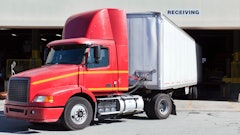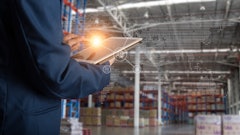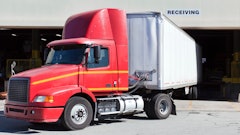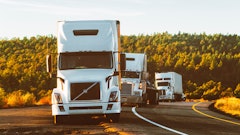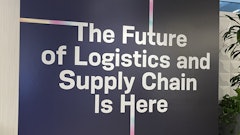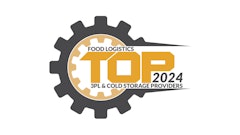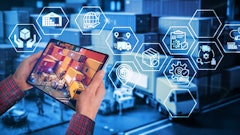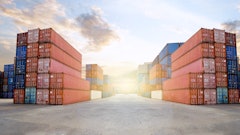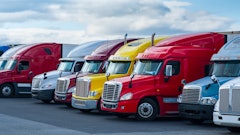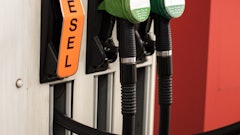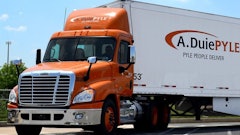
How automated is your supply chain? If your business supports e-commerce, it’s likely to employ a plethora of automated solutions from robotics to Internet of Things to artificial intelligence. While transformative technologies are prevalent in warehouses and distribution centers, they’re now extending beyond the dock doors to delivery vehicles. Commercial autonomous vehicles (AVs) are hitting the roads, serving the food and beverage industry in many shapes and sizes, from large freight trucks to small robotic AVs.
In its report, Distraction or Disruption? Autonomous Trucks Gain Ground in US Logistics, McKinsey & Company says, “65 percent of the nation’s consumable goods are trucked to market. With full autonomy, operating costs would decline by about 45 percent, saving the U.S. for-hire trucking industry between $85 billion and $125 billion.
“Already, companies have made fully autonomous beer deliveries and struck alliances to operate autonomous trucks jointly. The rigs these companies are using are typically new medium- and heavy-duty trucks, outfitted with lidars, sensors and other technology to allow the vehicle to operate without human intervention.”
Despite these technological advancements, fully autonomous commercial vehicles filling the roadways are still years away.
Power of Platooning
Autonomy is not an all-or-nothing capability, says Mark Petersen, VP of temperature-controlled logistics for C.H. Robinson. Instead, it’s a progressive continuum of ability. As figure 1 (below) highlights, there are five distinct levels of capabilities leading to complete self-driving vehicles.
While both levels 1 and 2 involve driver engagement and attention to the road, level 3 begins the path toward full automation where the vehicle navigates but a driver is still present for intervention. At both levels 4 and 5, complete self-driving is occurring with minimal human involvement at level 4 and no human driver required at level 5.
“The general consensus is that levels 1 through 3 will be reached in the next five years, and levels 4 and 5 are likely 10 or more years away,” says Petersen. “Based on these 5 levels, we are still on level 1 for the movement of food via trucks. Meaning, there isn’t a real impact today, depending on how autonomous is interpreted.”
Petersen adds that when you consider the planting, growing and harvesting of food, “tractors and other agricultural field equipment is far more sophisticated than highway driving when it comes to automation, but our focus is transportation on roads.”
McKinsey & Company says in its report that companies will see autonomous trucks roll out in four waves—in a platooning formation. The first wave begins with two trucks each with a single driver and gradually transitions to wave four with two or more fully autonomous trucks without drivers. “More than 10 years from now, we expect the first fully autonomous trucks, operating at scale without drivers from loading to delivery.”
Petersen says when platooning technology is engaged, drivers essentially drive as usual while wireless technology links each vehicle; a forward-looking radar sensor can sense obstacles ahead and automatically apply brakes in both trucks faster than humans can.
“When platooning, trucks can travel closer together than what’s safe when drivers are manually driving. The shorter gap between trucks positively alters aerodynamics, reduces wind resistance and results in fuel savings for both trucks,” he says.
Autonomous Impacts Beyond the Road
Platooning also has other impacts beyond the road. Petersen highlights four areas where structural, regulatory and employee changes are likely to occur.
- Physical structure adjustments. The physical structures created to support the movement of goods will need to change when automation increases. If and when platooning becomes more prevalent, there may need to be new requirements for parking facilities. If there is just one driver in the front truck, but a few other trucks behind him that mimic the front vehicle, what does that mean when they arrive at a delivery point? How do multiple trucks in a convoy unload at a dock? Is there enough space? Who is going to agree to this? Are drive-through loading locations going to change to be more like rail yards? Do we need to change how we design distribution centers? “We’ll have to ask ourselves if it enables a higher level of efficiency than we deal with today,” says Petersen.
- Facility resources. Understanding that last point of where autonomy stops and resources are needed to complete the transaction will be important. The technology will need to evolve or change to enable this.
- Regulations. Regulations have the potential to change, too. As autonomous vehicles don’t have to sleep, the hours of service may need to adjust based on the level of automation the industry is experiencing. Having autonomous vehicles on the road could also create a culture of more law-abiding drivers. From speed limits to using blinkers, there’s no human element to refute a law.
- Employee roles. Job roles are likely to change. More positions will be smarter versus task-oriented. And with vehicles tracked and monitored remotely, there might be better real-time visibility into delivery locations.
What do autonomous vehicles mean for the last mile? Petersen notes that while trucking has its growth opportunities in automation, the last mile poses opportunities for personal cars and other vehicle innovations beyond trucks and platooning.
In the food and beverage industry, the last mile means the point of consumption. From a curbside pickup to meal delivery, there are many automated ways to deliver food to consumers’ doors.
“When delivering to consumers, people are getting more comfortable with trusting others to handle and pick-out their food. In the past, it’s been emotional and often challenging to let someone else take ownership—due to food safety concerns or a belief that only the customer knows what is best for selecting the right level of ripeness, especially for produce,” says Petersen. “With more comfort delegating food orders, more doors are open to not just autonomous vehicles but drones and other robotic delivery mechanisms.”
Autonomous Urban Delivery Vehicles Evolve
Two companies focused on transforming autonomous last-mile food and beverage delivery are Refraction and Robomart. While each has a unique niche that it is servicing, both are eyeing innovative ways to enhance the customer experience through food logistics.
Refraction. Headquartered in Ann Arbor, Michigan, the company is piloting its REV-1 autonomous vehicle with Miss Kim, a Korean restaurant in Ann Arbor. The 80-pound, tricycle-shaped vehicle navigates city streets delivering food orders from Miss Kim’s to awaiting customers. Orders rest inside the vehicle’s shell during transport, while an app alerts customers when the REV-1 arrives for delivery. Customers enter a code on the vehicle and retrieve their order.
Ram Vasudevan, co-founder of Refraction, says the company is using five robotic REV-1 vehicles during its pilot with the expectation to expand reliable delivery throughout the U.S. “Our vehicle platform includes a multimodal suite of technology, including cameras, ultrasound and radar working together to navigate its surroundings,” says Vasudevan. “With our small footprint (at only 80 pounds), the vehicle has shorter stopping distances than full-sized autonomous vehicles while still having the sensing and machine learning built in to understand how to operate safely.”
He says consumer adoption of logistics services such as Postmates and Grubhub helps grow the interest and excitement of food delivery. However, trust in reliable delivery and at an affordable cost is of critical concern.
“Automation can provide a new asset for us to address consumer concerns around traffic safety and affordability. Our solution is a mixed-use vehicle that is slightly smaller than a car but can operate in traffic lanes and also pull to the side or use bike lanes if congestion or other issues occur,” says Vasudevan. “It’s also essential to keep the price of this service affordable so that we’re not charging $100 for delivering $5 worth of food, but still earning back the cost of the robot and more.”
Robomart. Ali Ahmed, founder and CEO of Robomart, Inc., acknowledges the significant investment companies are making in autonomous food delivery, spurred by Amazon’s entry into the space. Whether it’s sidewalk delivery robots or road-going autonomous vehicles, the goal is to remove the driver from the delivery equation to save on labor costs. However, those efforts may not yield the expected ROI.
“Delivery only accounts for 3 percent of groceries sold in the U.S. The technologies developed for last-mile food delivery may move the needle up to 5 percent, but more than 97 percent of all grocery sales still happen in store,” says Ahmed. “Robomart is pioneering a new way to sell goods through store hailing that provides retailers with a source of additional revenue, not just cost savings. With a button tap, the store comes to your doorstep or location where you can shop for precious goods.”
The Milpitas, California-based company focused its attention on the two most significant barriers to online grocery ordering—tangibility and cost. Ahmed says multiple studies show that the leading barrier for consumers ordering groceries online is the lack of tangibility.
“Consumers don’t trust an in-store associate or delivery person to pick their produce and other perishable goods,” he says. “Perishables account for 60 percent of all groceries sold—the largest category by far. However, in nearly three decades, it has never moved the needle in e-commerce sales; and the reason is tangibility.
“Cost is a secondary reason but garners the majority of the attention. Most people in the food industry believe that by reducing costs, they can make last-mile delivery exponentially grow,” adds Ahmed. “We simply don’t believe that’s true. Many grocery delivery companies such as Amazon Fresh, Instacart and others have never been profitable on a unit basis because using humans to pick delivered goods is prohibitively expensive.”
Holistically, the end-to-end process of in-store and online grocery shopping can be time-consuming for consumers, says Ahmed. With 33 million Americans making the daily trip to the grocery store and 70 percent purchasing less than 10 items per trip, it can present many inconveniences—driving to the store, parking, checkout lines and returning home. Online ordering has its annoyances, too—creating a shopping basket, searching individual items and quantities, price comparisons, checkout procedures and delivery wait times.
“With our technology, consumers grab and go, and we automatically charge their card at the end of the shopping engagement and send them a receipt,” explains Ahmed. “The entire end-to-end process is reduced to minutes and is frictionless—which resonates with end consumers. For both sides, the retailers (our customers) and consumers, we’ve created a win-win.”







